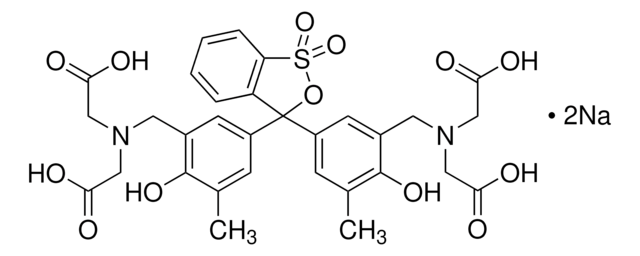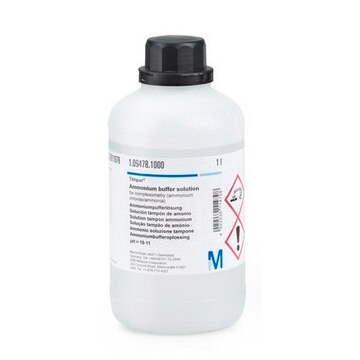1.03168
Eriochromblauschwarz B (C.I. 14640)
metal indicator
Synonym(e):
Eriochromblauschwarz B (C.I. 14640), 2-Hydroxy-1-(1-hydroxynaphthyl-2-azo)-naphthalin-4-sulfonsäure Natriumsalz
About This Item
product name
Eriochromblauschwarz B (C.I. 14640), metal indicator
Qualitätsniveau
Form
solid
Wirksamkeit
>5000 mg/kg LD50, oral (Rat)
Verlust
≤10% loss on drying, 110°C
pH-Wert
9.5 (20 °C, 10 g/L in H2O)
Löslichkeit
20 g/L
Schüttdichte
540 kg/m3
λmax
634-644 nm (buffer pH 10.0)
Lagertemp.
15-25°C
InChI
1S/C20H14N2O5S.Na/c23-17-11-18(28(25,26)27)14-7-3-4-8-15(14)19(17)22-21-16-10-9-12-5-1-2-6-13(12)20(16)24;/h1-11,21,24H,(H,25,26,27);/q;+1/p-1/b22-19-;
InChIKey
YRFCCVCSEVISHI-GXTSIBQPSA-M
Anwendung
- New palladium-oxazoline complexes: Synthesis and evaluation of the optical properties and the catalytic power during the oxidation of textile dyes.: This study examines new palladium-oxazoline complexes, focusing on their synthesis and evaluation of their optical properties and catalytic power in the oxidation of textile dyes, including Eriochrome Blue-Black B (Hassani et al., 2015).
- Wet air and catalytic wet air oxidation of several azodyes from wastewaters: the beneficial role of catalysis.: This research explores the application of wet air and catalytic wet air oxidation processes to degrade various azo dyes in wastewaters, highlighting the positive impact of catalysis in enhancing degradation efficiency, potentially applicable to Eriochrome Blue-Black B (Rodríguez et al., 2009).
Hinweis zur Analyse
Maximale Absorption λmax. (Puffer pH 10,0): 634–644 nm
Spez. Absorptionsgrad A 1 %/1 cm (λmax.; 0,025 g/L; Puffer pH 10,0; berechnet auf wasserfreie Substanz): 220–320
Trocknungsverlust (110 °C): ≤ 10 %
Eignung als Indikator (für die Metalltitration): entspricht
Signalwort
Warning
H-Sätze
Gefahreneinstufungen
Eye Irrit. 2
Lagerklassenschlüssel
11 - Combustible Solids
WGK
WGK 3
Flammpunkt (°F)
Not applicable
Flammpunkt (°C)
Not applicable
Analysenzertifikate (COA)
Suchen Sie nach Analysenzertifikate (COA), indem Sie die Lot-/Chargennummer des Produkts eingeben. Lot- und Chargennummern sind auf dem Produktetikett hinter den Wörtern ‘Lot’ oder ‘Batch’ (Lot oder Charge) zu finden.
Besitzen Sie dieses Produkt bereits?
In der Dokumentenbibliothek finden Sie die Dokumentation zu den Produkten, die Sie kürzlich erworben haben.
Kunden haben sich ebenfalls angesehen
Unser Team von Wissenschaftlern verfügt über Erfahrung in allen Forschungsbereichen einschließlich Life Science, Materialwissenschaften, chemischer Synthese, Chromatographie, Analytik und vielen mehr..
Setzen Sie sich mit dem technischen Dienst in Verbindung.



